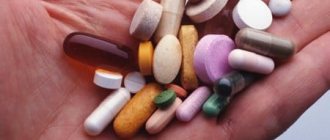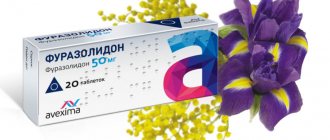Author of the article: Tironova Inna Igorevna
Gastroenterologist, therapist
15 years of experience
Professional skills: Colon hydrotherapy, treatment of gastrointestinal diseases
[adsp-pro-1]
To treat diarrhea caused by a bacterial infection, a gastroenterologist may prescribe Levomycetin Actitab to the patient. The drug has an antibacterial effect, due to which the patient’s digestion process quickly stabilizes. The frequency of medication and dosage are selected taking into account the patient’s age and the course of the disease.
How to use?
Tablets Levomycetin Actitab or regular Levomycetin should be prescribed by a doctor individually for each patient.
Take the tablet whole with plenty of water. Regular Levomycetin has a very bitter taste, so taking it can provoke a gag reflex. Levomycetin Actitab tablets are coated with a tasteless coating, so they are more convenient to take and there is no specific bitter taste. Take the drug 30 minutes before meals. For bacterial infections, adults are prescribed 250-500 mg 3-4 times a day. If necessary, the dose can be increased to 1 mg per dose. It is strictly forbidden to adjust the dose yourself, as the risk of side effects increases. The course of treatment with Levomycetin ranges from 3 to 14 days. It all depends on the diagnosis and the characteristics of the human body.
https://www.youtube.com/watch?v=fbG-l4kGtlY
For diarrhea or diarrhea not associated with an intestinal infection, sometimes a single dose of the drug is sufficient.
Levomycetin is prescribed to children only by a doctor. The dose and course of administration are selected individually in accordance with the age and body weight of the child. Some pediatric doctors do not recommend using Levomycetin for children, but prefer to replace it with other medications that are less aggressive and harmful.
During pregnancy, the use of Levomycetin tablets is not recommended, especially in the first trimester, when the formation of the fetus occurs. Levomycetin is also not used during lactation, since its active component passes into the mother's breast milk, which can harm the baby.
List of indications
Levomycetin Actitab tablets are prescribed when infections occur that are caused by microorganisms sensitive to chloramphenicol. These include various lesions of the biliary and urinary tract. Tablets can be prescribed for:
- paratyphoid;
- typhoid fever;
- brucellosis;
- salmonellosis;
- brain abscess;
- meningitis;
- osteomyelitis;
- whooping cough;
- dysentery;
- purulent peritonitis;
- purulent lesions of wounds;
- urinary tract infections;
- infectious skin lesions: trophic ulcers, bedsores, boils.
Levomycetin tablets are highly effective for various intestinal bacterial lesions that cause diarrhea.
Interaction with other drugs
Levomycetin tablets are less toxic than some other antibiotics. In most cases, when used correctly, they are well tolerated by the human body. In rare cases, after taking it or when the recommended dose of the drug is exceeded, side effects may occur, including:
- nausea, vomiting;
- bowel dysfunction;
- granulocytopenia;
- erythrocytopenia;
- anemia;
- increase or decrease in blood pressure;
- headache, dizziness;
- confusion;
- decreased visual acuity;
- skin rash;
- Quincke's edema.
If the above symptoms appear, you should stop taking the drug and inform your doctor, who will be able to select another drug. In more severe cases, you need to call an ambulance.
Levomycetin preparations are often used in combination with other drugs, but they should not be taken with other antimicrobial or antibacterial drugs, including sulfonamide drugs, cytostatics, and pyrazolone derivatives. If a person suffers from chronic diseases and regularly takes any medications, be sure to inform the attending physician.
- From the digestive system: dyspepsia, nausea, vomiting (the likelihood of development is reduced when taken 1 hour after a meal), diarrhea, irritation of the oral mucosa and pharynx, dermatitis, dysbacteriosis (suppression of normal microflora).
- From the hematopoietic organs: reticulocytopenia, leukopenia, granulocytopenia, thrombocytopenia, erythrocytopenia; rarely - aplastic anemia, agranulocytosis.
- From the nervous system: psychomotor disorders, depression, confusion, peripheral neuritis, optic neuritis, visual and auditory hallucinations, decreased visual and hearing acuity, headache.
- Allergic reactions: skin rash, angioedema.
- Other: secondary fungal infection.
It inhibits microsomal liver enzymes, therefore, when used simultaneously with phenobarbital, phenytoin, and indirect anticoagulants, there is a weakening of the metabolism of these drugs, a slower elimination and an increase in their concentration in plasma.
Reduces the antibacterial effect of penicillins and cephalosporins.
When used simultaneously with erythromycin, clindamycin, lincomycin, a mutual weakening of the effect is observed due to the fact that chloramphenicol can displace these drugs from the bound state or prevent their binding to the 50S subunit of bacterial ribosomes.
Simultaneous administration with drugs that inhibit hematopoiesis (sulfonamides, cytostatics), affecting metabolism in the liver, with radiation therapy increases the risk of side effects.
When prescribed with oral hypoglycemic drugs, their effect is enhanced (by suppressing metabolism in the liver and increasing their concentration in plasma).
Myelotoxic drugs increase the manifestations of hematotoxicity of the drug.
Pharmacology
The drug refers to drugs that inhibit bacterial activity in the body. This is achieved by disrupting protein synthesis in the cells of pathogenic bacteria. Levomycetin is a broad-spectrum antibiotic.
The activity of the pharmacological drug is manifested in relation to:
- Streptococcus.
- Shigella.
- Salmonella
- Coxiella burnetii.
- Burkholderia pseudomallei.
- Klebsiella pneumoniae.
[adsp-pro-2]
They also act on other pathogenic strains of bacteria. The action of the antibacterial drug is ineffective against acid-fast, anaerobic bacteria, enterococci, fungi and protozoa.
The active component very quickly reaches its maximum concentration in the blood. After just 1 hour of taking the tablets, the number of pathogenic bacteria in the tissues decreases. Chloramphenicol is effectively distributed in liquids; in a therapeutic dose, it remains in the blood for up to 5 hours, continuing its effect on bacteria.
The time it takes for the antibiotic to leave the body is 24 hours. More than 90% of the active element is excreted by the kidneys, and up to 3% of chloramphenicol is excreted through the intestines with feces.
Composition and release form
For 1 tablet 250 or 500 mg:
- Active ingredients: chloramphenicol - 250 mg or 500 mg;
- Excipients: colloidal silicon dioxide (Aerosil), microcrystalline cellulose, povidone, crospovidone, calcium stearate, for a dosage of 250 mg - opadry II (series 85) (polyvinyl alcohol, macrogol, talc, titanium dioxide, aluminum varnish based on indigo carmine dye, iron yellow oxide), for a dosage of 500 mg - opadry II (series 85) (polyvinyl alcohol, macrogol, talc, titanium dioxide, aluminum varnish based on indigo carmine dye, yellow iron oxide).
Tablets with a dosage of 250 or 500 mg in quantities of 10, 12 or 15 pieces in a blister pack made of polyvinyl chloride or imported film and printed varnished or imported aluminum foil. 1, 2, 3, 4, 5 or 6 strip packaging along with instructions for use are placed in a cardboard pack.
Levomycetin for children
Treatment with Levomycetin is justified; the drug should be given to children with caution and only as prescribed by a doctor. In pediatrics, it is not recommended to take the drug for mild forms of bacterial infection. If a child needs to take an antibiotic, doctors are more often inclined to prescribe erythromycin and only in rare cases can they prescribe Levomycetin.
Levomycetin is prescribed to children over 3 years of age. The initial dose of the drug should not exceed 125 mg 2 – 3 times a day. For adolescents, the dose may be increased to 250 mg 2 times a day. Only a doctor can adjust the dose to a child, as well as prescribe the drug itself, after the results of the examination and identification of the pathogenic pathogen.
For some adults, Levomycetin Actitab or regular one is the first aid for diarrhea, so they no doubt use it for children. It is important to note that Levomycetin is a fairly strong antibiotic, so for minor stool disorders, it is better to use safer and more effective medications: Nifuroxazide, Enterol, which are intended for intestinal infections accompanied by loose stools.
Contraindications
Do not forget that this is an antibiotic, and quite a powerful one; you should not take it yourself, without a doctor’s prescription. Like any medical product, the medicine is accompanied by a number of cases that do not allow its use:
- The drug is not recommended for use if the patient has kidney or liver dysfunction.
- Diseases of the hematopoietic organs.
- Pre-diagnosed acute intermittent porphyria.
- Intolerance or sensitivity to any component of the drug.
- The presence of certain skin diseases - eczema, psoriasis, mycosis, fungal infections.
- The medicine is not suitable for use by young children under three years of age and weighing less than twenty kilograms (a “gray syndrome” may occur - a phenomenon when individual components accumulate in the child’s body due to the inability of the liver to cope with them and have a toxic effect on the child heart).
- Pregnant and breastfeeding women should avoid using the medicine.
If diarrhea is caused by a chronic illness, the tablets will be ineffective. If diarrhea lasts more than one day, the drug is not used. It is not recommended for use by people who have previously been treated with cytotoxic drugs or have undergone radiation. The use of the drug is not prohibited, the course of treatment is carried out under the strict supervision of the attending physicians.
Levomycetin during pregnancy and lactation
The use of Levomycetin during pregnancy significantly increases the risk to the fetus, especially in the first trimester. The active component of the drug has the ability to penetrate the placenta, so it can harm the growth and development of the fetus. In very rare cases, this drug can be prescribed to pregnant women, but only in cases where the effect of therapy does not exceed the potential risk to the fetus.
During breastfeeding, taking Levomycetin is contraindicated. The active components of the medicine pass into breast milk and therefore can cause serious complications and adverse reactions in the baby. While taking this drug, you should stop breastfeeding.
Reception features
The use of Levomycetin preparations should only be carried out as prescribed by a doctor. Uncontrolled use of this medication can cause significant harm to health and provoke severe adverse reactions in the body.
It is prohibited to take the drug simultaneously with alcohol; this can lead to a disulfiram reaction in the body, which is characterized by convulsions, tachycardia, nausea, vomiting and other unpleasant and severe symptoms.
Adjusting the dose of the medicine or using it more than the prescribed course is also strictly prohibited. If you feel better after taking Levomycetin, you should not interrupt the prescribed course of treatment, as the risk of relapse of the disease will increase.
There is no data in the instructions on whether Levomycetin affects driving and whether its use disrupts concentration. In any case, it is important to remember that Levomycetin, like its analog Levomycetin Actitab, are strong antibiotics, so they should only be taken as prescribed by a doctor.
Causes of diarrhea and processes occurring in the body
Diarrhea, according to the medical concept of diarrhea, is a rather unpleasant phenomenon, which consists in the fact that liquid and beneficial elements do not have time to be digested and absorbed into the circulatory system, as a result of which they are excreted from the body during bowel movements. For this reason, feces are very liquid.
With diarrhea, as a result of large loss of fluid, dehydration of the body is possible and, as a result, dizziness, weakness, and loss of consciousness. Sometimes, in acute poisoning, severe intoxication of the body with fatal outcome is possible.
The causes of diarrhea can be very different, namely:
- Poisoning from low quality food or poorly washed vegetables and fruits.
- Penetration of various pathogenic microbes into the human body due to unwashed hands and drinking raw water.
- Severe stress.
Often, diarrhea is one of the signs of chronic diseases of the digestive system: gastritis, pancreatitis, colitis and diabetes mellitus. For this reason, you should seek qualified medical help, do not take medications on your own and do not resort to traditional medicine recipes.
Release form and methods of application
Orally 30 minutes before meals, and if nausea and vomiting develop - 1 hour after meals, 3-4 times a day.
Single dose for adults - 0.25–0.5 g, daily dose - 2 g.
In severe forms of infections (in a hospital setting), it is possible to increase the dose to 3-4 g per day (under monitoring the blood condition, kidney and liver function).
Children over 3 years old and/or weighing more than 20 kg are prescribed 12.5 mg/kg every 6 hours or 25 mg every 12 hours, for severe infections - up to 75–100 mg/kg per day (under drug concentration control in blood serum).
The average duration of treatment is 8–10 days.
Levomycetin actitab is produced in the form of tablets for oral administration. Each tablet is coated with a special film of a light blue hue. In appearance they are oblong in shape, with graphene in the middle. In a cross section, two layers are clearly demarcated. The inside of the tablet is white or with a yellow tint.
The dosage of the dosage form is 250 and 500 mg. One aluminum foil blister contains 10, 12 and 15 tablets. One cardboard box contains from 1 to 6 blisters and instructions for use. Tablets are stored at room temperature not exceeding 25°C, away from sunlight.
Dosage regimens
The drug is taken orally half an hour before meals. The number of appointments is from 2 to 4, depending on the diagnosis. The maximum daily dose of an antibiotic should not exceed 2 g. If the patient is seriously ill and is in hospital treatment, the dosage can be increased to 4 g per day. At the same time, he must be under constant supervision.
Chloramphenicol is prescribed to children from 3 years of age and only if their body weight is at least 20 kg. Young patients are prescribed tablets containing the active substance 250 mg or 0.25 g. Give 1 tablet every 12 hours or ½ tablet. every 6 hours. If a child has a severe infection, the maximum daily dose may be increased to 100 mg per kg of weight to help him. At the same time, constant monitoring of the concentration of the substance in the blood plasma is carried out.
The duration of the antibacterial course is 8-10 days.
For diarrhea, the maximum course of treatment is 7 days. If there are blood impurities in the stool, then the antibiotic continues to be taken for 15 days.
Vaginitis
Vaginitis is a disease of the vaginal mucosa of an infectious-inflammatory nature. The disease manifests itself in the form of burning, itching and vaginal discharge. In some cases, the mucous membrane of the cervical canal and external genitalia is involved in the process.
- Causes of vaginitis
- How is vaginitis transmitted?
- Symptoms of vaginitis
- Types of vaginitis
- Specific
- Non-specific
- Bacterial vaginitis
- Atrophic vaginitis
- Acute vaginitis
- Subacute vaginitis
- Chronic vaginitis
- Candidal vaginitis
- Trichomonas vaginitis
- Aerobic vaginitis
- Gonorrheal vaginitis
- Vaginitis in virgins
- Vaginitis during pregnancy
- Diagnostic examination
- Complications of vaginitis
- Treatment of vaginitis
- How to treat vaginitis
- Suppositories for vaginitis
- Antibiotics for vaginitis
- Folk remedies
- Preventive measures
- Conclusion
The formation of the disease is based on disruption of the vaginal protective system. Normally, it contains opportunistic microflora, the amount of which is controlled by lactobacilli.
Before we talk about control methods, let's first talk about the causes and methods of transmission of the disease. It is possible to completely get rid of the disease only if the etiological factor is eliminated.
Causes of vaginitis
Vaginitis can occur at any age. In most cases, several factors are simultaneously involved in the formation of the pathological process. A specific type develops with sexually transmitted diseases. During unprotected sexual relations, pathogenic microflora penetrates the vagina.
If we talk about the nonspecific form, then the catalyst for its appearance are factors that lead to a deterioration of the vaginal biocenosis. As a result, the opportunistic microflora gets out of control and begins to actively multiply, causing vaginitis.
Let's consider the popular causes of nonspecific vaginitis:
- long-term stressful situations. It’s not for nothing that they say that all problems come from nerves. Interestingly, both the stress hormone and progesterone are formed from the same substance, which is why stress can lead to hormonal imbalance;
- poor adherence to intimate hygiene rules. This creates favorable conditions for the proliferation of pathogens;
- autoimmune processes, hypothermia, colds - all this leads to a weakening of the immune system. As a result of a decrease in the protective function of the vagina, pathogenic microorganisms feel like “masters of the situation,” which leads to vaginitis;
- uncontrolled or long-term use of antibacterial or cytostatic drugs. As you know, antibiotics affect not only harmful, but also beneficial bacteria, and it is they who control the growth and reproduction of pathogenic microflora;
- diabetes mellitus, obesity, polycystic ovary syndrome. All these diseases are based on metabolic disorders, which also affects the metabolism of female hormones;
- pregnancy, during which a restructuring of the female body occurs;
- menopause;
- violent sexual intercourse, douching, vaginal trauma, abortion, curettage - all this can lead to damage to the vagina. Due to the violation of the integrity of the mucous membrane, the risks of infection increase significantly.
READ MORE: Rotten fish smell due to candidiasis
Much depends on the type of pathogen. For example, trichomonas vaginitis is a sexually transmitted disease, but bacterial vaginitis is not. The causative agents of this disease are transmitted through sexual contact.
If we are talking about a bacterial or candida species, then in these cases the transmission of the pathogen from one woman to another is excluded, because opportunistic microflora is part of the natural microflora of the female body.
However, unprotected sex and frequent changes in sexual contact can affect the development of the disease. And the point here is not a matter of infection, but a violation of the natural biocenosis.
Symptoms of vaginitis
Depending on the etiological reasons for the development of vaginitis, the symptoms may vary greatly. Let's look at the general symptoms characteristic of various types of disease:
- change in vaginal discharge in smell, quantity and character;
- itching and burning;
- in the vaginal area and external genitalia there is a feeling of fullness and squeezing;
- urinary disturbance;
- pain during intimacy;
- after sexual intercourse, bloody vaginal discharge may appear;
- disturbance of the general condition in the form of malaise and increased body temperature.
Types of vaginitis
The disease may differ depending on the type of pathogen, as well as the nature of the pathological process. Vaginitis can be specific and nonspecific.
Possible side effects in case of overdose
Symptoms: nausea, vomiting.
Treatment: gastric lavage, symptomatic therapy, hemosorption.
In case of an overdose of the drug, negative side effects for the body often occur.
. The most pronounced signs of overdose:
- irritation of the oral mucosa, severe nausea, dyspeptic disorders, dysbacteriosis;
- mental disorders, nervous and emotional tension, irritation, dysfunction of the sensory organs, hallucinations, headaches;
- allergic manifestations - skin itching, rashes, redness, peeling, urticaria, angioedema;
- violation of the quantitative composition of the blood - decrease in red blood cells, platelets, leukocytes, hemoglobin.
The most dangerous complication when taking an antibiotic, which can lead to death, is irreversible aplastic anemia. This is the inhibition and complete cessation of the formation of blood cells in the bone marrow.
Subjective symptoms of drug overdose:
- loss of strength and body temperature;
- pale skin color with a gray tint;
- arrhythmic breathing;
- lack of reactions to external stimuli;
- development of cardiovascular failure.
Levomycetin actitab helps to achieve a rapid therapeutic effect in severe infections. It is included in the list of vital and essential medicines. But the drug cannot be taken independently, without a diagnosis and recommendations from a doctor. This is due to its toxicity, which poses a serious health threat.
Who is the medication contraindicated for?
In international medical practice, it has been decided not to prescribe Levomycetin for inflammatory processes in the genitourinary area, if it is possible to replace it with another drug. When Levomycetin is prescribed, the instructions for use of the tablets inform that the drug should be taken with extreme caution and only under the supervision of a specialist by people with pathological liver and kidney disorders. In addition, in such patients the concentration of chloramphenicol in the blood should be constantly monitored to adjust the dose.
If in a person without pathologies, the removal of the drug from the body begins after 3-3.5 hours, then in patients with chronic kidney or liver disorders - up to 4 and 11 hours, respectively. The medicine is not prescribed if the underlying diseases of cystitis are fungal skin infections, eczema, sore throat and other respiratory diseases.
An overdose of Levomycetin very quickly manifests itself in the appearance of a number of symptoms:
- pale skin;
- temperature increase;
- headache;
- nausea and general weakness;
- rupture of tissue vessels and, as a result, the appearance of hematomas;
- internal bleeding is possible;
- visual and hearing impairment.
The first action when at least one of the above symptoms appears is to stop taking the drug and lavage the stomach.
Thus, a large number of side effects, contraindications and high toxicity of Levomycetin completely exclude self-treatment with the drug.
special instructions
Severe complications from the hematopoietic system are usually associated with the use of high doses for a long time.
Carefully
Patients who have previously received treatment with cytotoxic drugs or radiation therapy.
During pregnancy and breastfeeding, the use of the drug is contraindicated.
When taking ethanol simultaneously, a disulfiram-like reaction may develop (facial hyperemia, spasm in the abdomen and stomach area, nausea, vomiting, headache, decreased blood pressure, tachycardia, shortness of breath).
During the period of treatment with the drug, caution must be exercised when driving vehicles, machinery and engaging in other potentially hazardous activities that require increased concentration and speed of psychomotor reactions.











